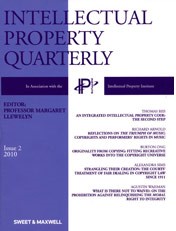Extracting the price of a patent: enablement and written description
This article considers the development of the patent specification and discusses more recent developments in UK and US law concerning enablement, sufficiency and written description.

15 December 2012
Publication details
Fisher, Matt J (2012). Extracting the price of a patent: enablement and written description. Intellectual Property Quarterly, 4 pp. 262-288.
Abstract
The patent is a somewhat curious legal creation. It provides exclusivity in an information source—the invention—that is, in economic terms, both free and public. The patent system creates a framework within which this information can be controlled, and this, in turn, enables limitations to be placed upon its supply and use. Information is itself a wayward thing: difficult to tame and coax into proprietary regimen. Economically speaking, it is a non-wasting asset; one whose utility is not lessened by widespread use.
The patent system facilitates the formation of property in the subject matter that it protects. But for the patent system, ‘property’ in an invention simply does not exist. The invention is only property because it is protected by a patent, because this imposes a structure of scarcity, and not vice versa. Accordingly, the patent is not to be thought of lightly. The grant of exclusivity takes from the public a freedom that they were previously at liberty to enjoy. If nothing more, it removes the possibility of exploring and commercialising the self-same pasture - developing the same prospect that the patentee now asserts as their own. A price must therefore be paid: the public must be compensated for the inconvenience that the grant of exclusivity imposes upon them. Within a framework that has been developed on an international basis over many hundreds of years, the agreed toll has been standardised. Ignoring the financial, essentially administrative, costs that the patentee must meet to secure their grant (bureaucratic costs not fundamentally associated with public inconvenience), the real price of the patent is disclosure: informing the world of your invention and, critically, providing them with instructions which enable one skilled in the art to replicate it without undue burden.
This article considers the birth and development of the specification (the chosen vessel for communicating the invention to the public) and the interpretation of the standards to which is it now held. It briefly examines the genesis of the English patent custom, a system whose roots extend further than any other extant patent regime, and that in the United States (a system grown from an English seed, but which rapidly evolved from its anglicised beginnings). It then discusses more recent developments in the law concerning enablement, sufficiency and written description concentrating on UK and US jurisprudence in this area.
 Close
Close

